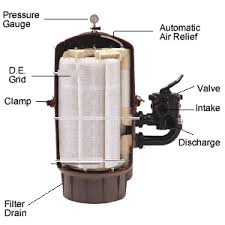 D.E. pool filters, or diatomaceous earth filters, are the most efficient pool filters on the market today. They trap particles down to 3-5 microns, that’s way more than the naked eye can even see. How did D.E. filters become to well-known?
D.E. pool filters, or diatomaceous earth filters, are the most efficient pool filters on the market today. They trap particles down to 3-5 microns, that’s way more than the naked eye can even see. How did D.E. filters become to well-known?
Most people don’t spend their time in history class learning the importance of diatomaceous earth in the filtration world. It is often referred to as the workhorse of the filtration industry. It clarifies nearly every type of liquid you can think of: juice, beer, oils, pharmaceuticals, just to name a few.
DE comes from the fused frustules of single cell plants called diatoms. Basically a particle from a very, very small plant. The diatoms are usually referred to as the beginning of the food chain in the ocean and they are responsible for harboring much of the world’s atmospheric CO2. Life on earth would literally not exists the way it does now without diatomaceous earth.
How does all of that relate to pool filtration?
Good question. D.E. was first used to filter pools in a 1930’s aqua musical by Esther Williams. The pool water was continuously cloudy and needed to be constantly replaced. This simply wasn’t working, so the studio hired top engineers in the area to solve the problem. Those engineers developed the first commercial pool filter. After much experimentation, D.E. was selected as the ideal media to keep the water crystal clear. Ever since this experimentation, pool builders bought on to the idea of D.E. filtration.
Because D.E. is able to remove particles as small as 3 microns, it can catch harmful pathogens in the water we don’t even know about. For example, D.E. is an effective way to capture Cryptosporidium (crypto). Crypto is a harmful pathogen similar to giardia. After many studies, it was concluded that D.E. filters were the most effective water treatment system to catch these pathogens. D.E has 99.4% effectiveness rating in pathogen removal. That sounds like a great thing to have as part of my swimming pool.
Why are some people weary of D.E.?
Simply put- D.E. is a class 1 carcinogen. That sounds scary when you don’t follow up with an explanation. It is only a carcinogen when it becomes airborne. There are other class 1 carcinogens no one seems to pay much attention to such as sand, filter sand, plaster dust, and sawdust. You most likely ingest D.E. through beer or even soda. It’s completely safe. the FDA labeled D.E. as an ‘incidental food additive’ because it’s so widely used in the beverage industry.
When adding D.E. into a filter, wear a mask. Once it has been wet, it no longer poses any hazard to your health. You can easily clean up spills when they are washed away with water. Again, with the addition of water, harmful dust particles are no longer an issue.
